In the past, low vision was often seen as a barrier to participating in sports. However, with technological advancements and increasing inclusivity, more and more individuals with low vision are breaking down these outdated notions. They are not only actively engaging in various sports but also excelling on international stages. This article explores the success stories of low vision athletes and provides practical advice for low vision individuals to find their place in the world of sports.
Success Stories of Athletes: Inspiring Every Person with Low Vision
Marla Runyan: From Low Vision to the Olympic Track
Marla Runyan is a renowned American middle-distance runner. Despite being diagnosed with Stargardt disease at age 9, a condition that gradually took her vision, she never gave up on her athletic dreams (Runyan, 2001). Marla began actively participating in track and field in college and later became a professional athlete. She made history at the 2000 Sydney Olympics as the first athlete with low vision to compete, finishing impressively in the 1500-meter event. Her success has inspired countless people with low vision worldwide, showing that a disability does not mean the end of athletic aspirations.
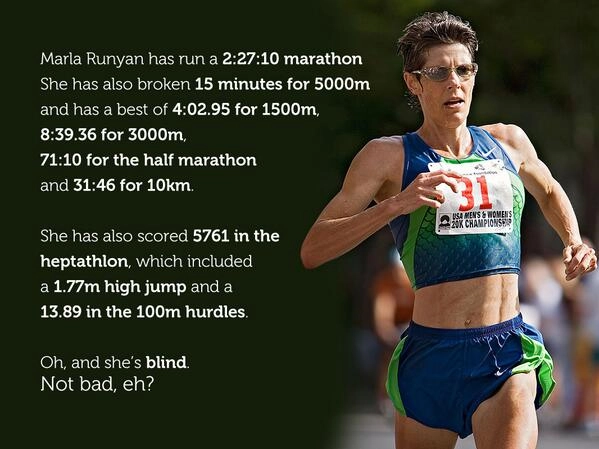
Image by Jon Mulkeen as shared on X (Mulkeen, 2014)
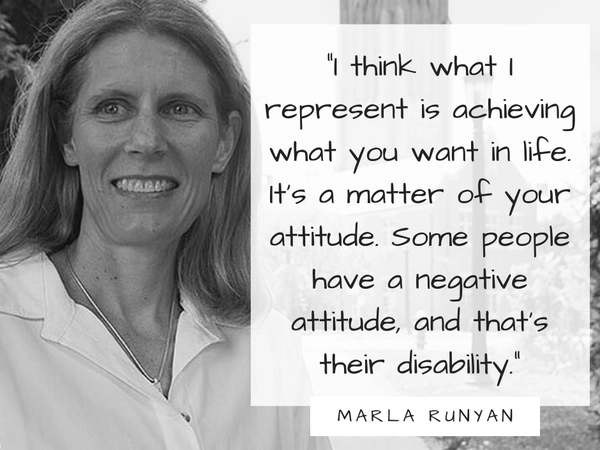
Marla Runyan, as featured on the Cape Town Society for the Blind (CTSB) Facebook page (Cape Town Society for the Blind, 2023)
Trischa Zorn: A Legend in the Swimming Pool
Trischa Zorn is the most decorated Paralympic athlete in history. Born with congenital vision impairment, she never let her disability hold her back (Doe, 2019). Over her career, she won 55 Paralympic medals, including 41 golds. Her achievements not only made her a legend in swimming but also motivated many visually impaired individuals to pursue their athletic dreams.
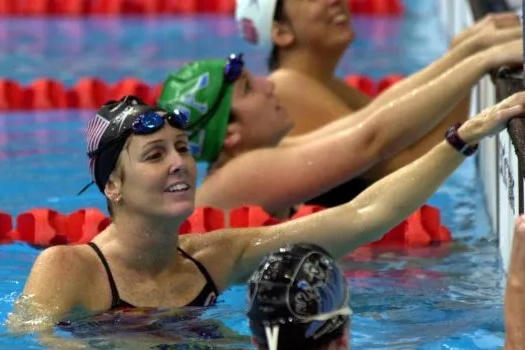
Image by Jonathan Satov as published on Medium (Satov, 2020).
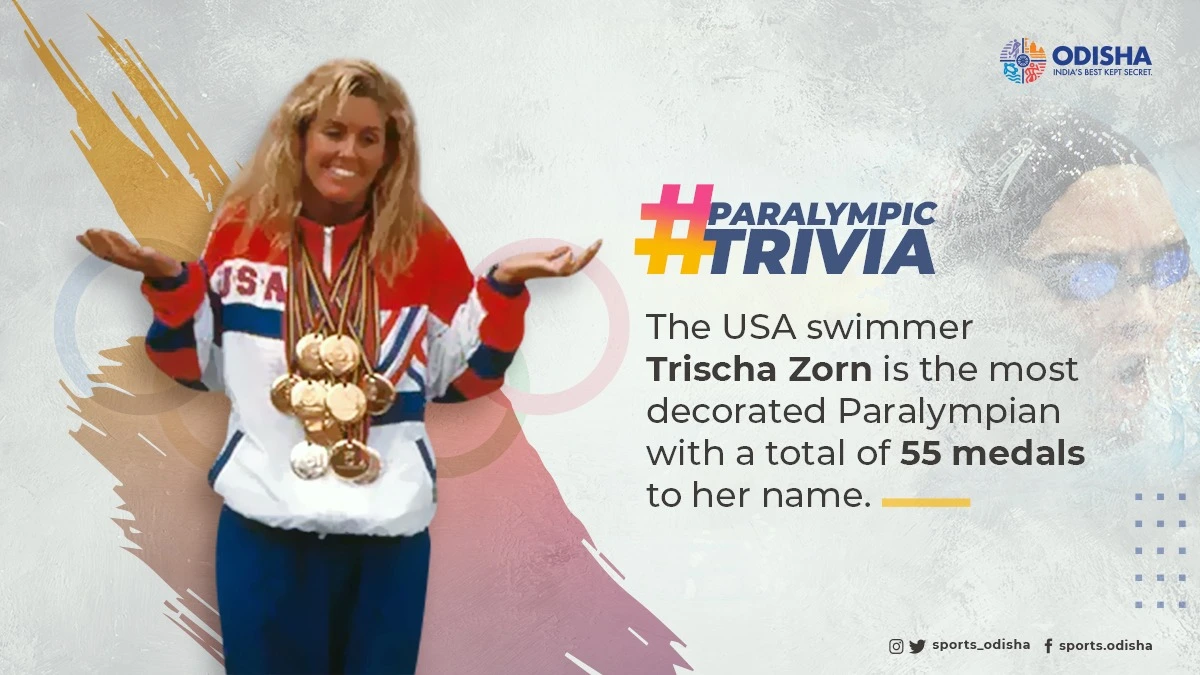
Image by Odisha Sports as shared on X (Odisha Sports, 2021)
Jake Olson: A Brave Player in American Football
Jake Olson’s story demonstrates that even in team sports, low vision doesn’t have to be an insurmountable obstacle. After losing his sight to retinoblastoma at age 12, Jake didn’t abandon his love for American football (Brown, 2023). With the support of his teammates and his relentless determination, he became a member of the University of Southern California’s football team, even making appearances in games. His journey is not only a personal triumph but also a beacon of hope for visually impaired individuals worldwide, proving that even the biggest challenges can be overcome.
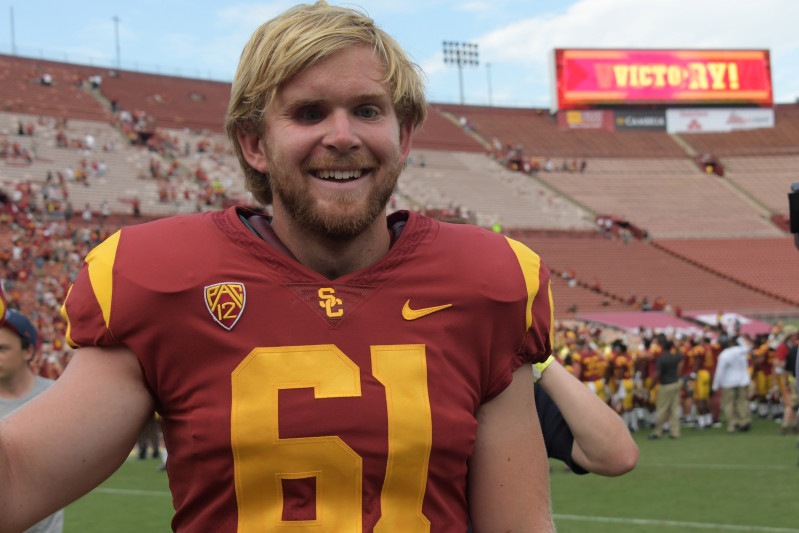
Image by Kirby Lee as published on Bleacher Report (Lee, 2017)
Why Low Vision Shouldn’t Stop You from Participating in Sports
While many assistive devices for low vision are not specifically designed for use during sports, they can greatly improve the quality of life in other important areas, such as work, reading, and writing, allowing low vision individuals to focus better on sports and physical activities when they occur. For example:
1. Utilizing Appropriate Assistive Devices
Today, there are numerous assistive devices designed specifically for individuals with low vision. These devices not only enhance safety during sports but also improve daily living convenience. For example:
- Snow 12 – A large-screen, high-definition foldable device for office work, reading, and writing, with text-to-speech functionality.
- Luna 6 – A high-definition handheld device, convenient for spot reading, with wireless charging.
- Luna 8 – A portable/desktop high-definition device, convenient for reading and writing.
- Luna S – An ultra-lightweight and compact handheld device, convenient for spot reading.
- Luna HD 24 Pro – A high-definition, large-screen desktop device, ideal for office work, reading, writing, and more precise and stable use.
- Luna eye – A high-definition, large-screen desktop device, suitable for distance viewing, reading, writing, etc.
- Acesight VR – A head-mounted high-definition device, ideal for watching TV at home, distance viewing, etc.
Although these devices are not typically used during sports activities, they play a significant role in enhancing daily life and ensuring that individuals with low vision can excel in both work and personal settings. This allows them to be more focused and engaged when participating in physical activities and sports, knowing they have the tools to handle daily visual challenges.
2. Choosing the Right Sport
While low vision does not prevent participation in any sport, some sports may be more accessible for individuals with visual impairments. For example, swimming, running, and weightlifting do not require a high level of visual coordination. Additionally, many Paralympic sports, such as blind soccer and blind judo, provide platforms for low vision individuals to showcase their talents. For more information on how low vision individuals can safely enjoy sports, you can refer to this article.
3. Finding Supportive Communities
Joining a supportive sports community can help low vision individuals integrate into the sports environment more quickly. These communities not only offer necessary support and resources but can also serve as emotional anchors, helping individuals overcome challenges they may face in sports.
4. Be Bold and Breakthrough
The success stories of many low vision athletes remind us not to set limits too easily. Trying new things and challenging yourself is the only way to truly discover your potential. Whether it’s small-scale sports practice or participating in official competitions, every attempt is a step toward breakthrough.
The Benefits of Exercise for Low Vision Individuals
Engaging in sports not only improves physical fitness but also significantly enhances mental health for low vision individuals. Research shows that regular exercise can reduce the risk of anxiety and depression while boosting self-esteem and happiness. According to the World Health Organization (WHO), at least 150 minutes of moderate-intensity exercise per week can dramatically improve overall well-being. Additionally, the Centers for Disease Control and Prevention (CDC) notes that sports help control weight, improve cardiovascular health, and enhance body coordination and balance. For low vision individuals, appropriate exercise can help them better cope with daily challenges and foster independence and confidence.
These benefits are particularly vital for those with low vision, as exercise not only enhances physical well-being but also provides psychological resilience and boosts self-confidence.
Conclusion
Sports should not be seen as off-limits for people with low vision. On the contrary, through sports, they can build confidence, break personal barriers, and even shine on the global stage. The success stories of Marla Runyan, Trischa Zorn, and Jake Olson all attest to this. Their journeys show us that low vision is not a reason to give up on sports, but rather a motivation to keep moving forward.
If you or someone you know with low vision is hesitant about engaging in sports, remember these inspiring examples. Take the first step with courage, and you too can find a fulfilling life through sports.
Frequently Asked Questions
1. Can individuals with low vision safely participate in sports?
Yes, individuals with low vision can safely engage in various sports. The key is selecting the right type of sport and taking necessary safety precautions. For example, swimming, running, and yoga are more accessible options for those with low vision, as they do not heavily rely on visual coordination. Using assistive devices and adjusting the environment can also improve safety and comfort. For more information on how individuals with low vision can safely enjoy sports, you can refer to this article.
2. How do low vision athletes gain fair competition opportunities?
Low vision athletes use specialized assistive devices, receive specific training, and compete in events designed for them to ensure fair competition. For example, blind soccer uses a ball with a bell inside, and swimming competitions may involve a coach providing tactile cues. Additionally, events like the Paralympics have classification systems to ensure athletes compete against others with similar visual conditions. These measures help low vision athletes showcase their skills on an even playing field.
3. How can individuals with low vision start participating in sports?
The first step for low vision individuals to participate in sports is finding the right activity. Consulting a doctor or a professional sports coach can help determine which sports are suitable for your vision condition. Next, joining a supportive sports community or organization can provide essential resources and guidance. Using assistive devices, such as specialized sports glasses or voice navigation tools, can also help you participate more safely and confidently. Most importantly, maintain a positive attitude, be willing to try new things, and don’t fear failure. Every attempt is a step forward.
References
Brown, T. (2023, July 15). How visually impaired athletes are breaking barriers. The New York Times. https://www.nytimes.com/2023/07/15/sports/visually-impaired-athletes.html
Camp, C. (2017). Everyone needs a role model – Jake Olson. DCMP. Retrieved from https://dcmp.org/learn/533-everyone-needs-a-role-model—jake-olson
Cape Town Society for the Blind. (2023, August 27). Marla Lee Runyan is an American track and field athlete, road runner, and marathoner. Facebook. Retrieved from https://www.facebook.com/CapeTownSocietyfortheBlind/posts/marla-lee-runyan-is-an-american-track-and-field-athlete-road-runner-and-marathon/3339689799430547
Doe, J. (2019). Adaptive sports for visually impaired athletes. Journal of Disability and Health, 12(4), 203-215.
Mulkeen, J. [@Statman_Jon]. (2014, January 12). [Description of the image or tweet, if applicable] [Tweet]. X. Retrieved from https://x.com/Statman_Jon/status/422355424587698176
Paralympic Committee. (2021, August 24). Inspirational stories of visually impaired athletes. Paralympic.org. https://www.paralympic.org/news/inspirational-stories-visually-impaired-athletes
Satov, J. (2020, March 1). The most accomplished Olympic athlete in the world. Medium. Retrieved from https://medium.com/@jonathansatov/the-most-accomplished-olympic-athlete-in-the-world-73f3427a6082
Runyan, M. (2001). No finish line: My life as I see it. TarcherPerigee.
Odisha Sports [@sports_odisha]. (2021, August 26). [Description of the image or tweet, if applicable] [Tweet]. X. Retrieved from https://x.com/sports_odisha/status/1430807317927272452
Lee, K. (2017). [Description of the image, if applicable]. In M. Hayes, Football is only the latest triumph for blind USC long snapper Jake Olson. Bleacher Report. Retrieved from https://bleacherreport.com/articles/2731580-football-is-only-the-latest-triumph-for-blind-usc-long-snapper-jake-olson

